| Lena Bergendahl | The Celestial Equator: Diffractions | 2012 | 11:39 min. | |
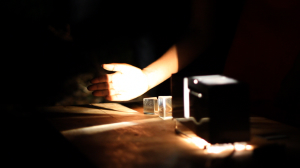 |
Lena Bergendahl’s film series The Celestial Equator is set in Kenya, and its two young female protagonists play the role of contemporary scientists. The experiment is a modification of the Swedish poet and researcher Samuel von Triewald’s attempt in 1739 to explain the origin of the northern lights. In Diffractions, Bergendahl has removed these lights from their natural setting, the polar circle. She lets the experiment be executed near the equator, in order to investigate which differences may arise. |
| Lena Bergendahl | The Celestial Equator: Formations | 2012 | 6:02 min. | |
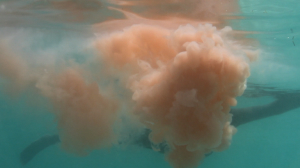 |
In the last film of the trilogy, Formations, the women prepare jars of coloured mixtures while sailing in a small boat on an open sea. Then, diving underwater, they pour the mixtures into the ocean and wonderful sea clouds tinted yellow, red, purple, pink, and blue cluster together, like odd sea-plants, building an architecture for the women to swim through. The screen appears painted – it becomes an artificial landscape. This colour technique originates from 1970s sci-fi film productions, when water tanks were filled with fluid to create atmospheric effects, like the illusion of clouds. |
| Cecilia Bonilla | Making it come true | 2010 | 6:56 min. | |
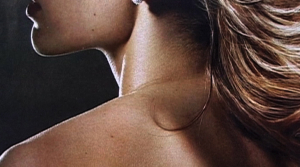 |
Bonilla appropriates mass-produced images from sources such as glossy magazines, product catalogues, advertising and the internet, to produce works ranging from small-scale collages, photographs, videos and sculptures to large installations and site specific interventions. Through the use of manual intervention and digital manipulation her practice explores subjects such as the nature of our relationship with the commercial image, mass media images related to women and notions of being a woman and the domestic space. Her videos and collages are often produced in a 'homemade-low-tech' manner, 'physically' animating still images by using lo-fi techniques such as simple camera movements, light flickering, sound, and the addition of new elements, such as human hair, studs and paint. In each case she restates the purpose of an image's existence - changing the rules, so that expectations of how they are primarily designed to function become altered, thus questioned. |
| Johannes DeYoung | Ego Loser | 2012 | 5:54 min. | |
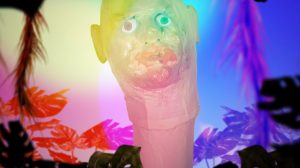 |
Ego Loser is part of a series of animated talking-head videos that utilize the language of self-help and positive affirmation, email spam, and other detrital language to express the boundaries between physical reality and psychic understanding. Humor and exaggerated forms expand into absurd narratives, confronting mortality and failure, as the talking-head professes esoteric advice and affirmations despite his unstable, amorphous physical condition. Johannes DeYoung received his MFA from the Cranbrook Academy of Art in 2006. His work has been exhibited at Jeff Bailey Gallery, New York, NY; Pallas Projects, Dublin, Ireland; in Brooklyn at Interstate Projects, The Parlour, Vaudeville Park and NutureArt; Grizzly Grizzly, Philadelphia; Real Art Ways, Hartford and Hell Gallery, Melbourne, Australia. He lives and works in New Haven, Connecticut. |
| Roy Menachem Markovitch | Untitled; Bad Seeds; Floating Stones | 2008-11 | 4:42 min.; 0:09 sec; 2:25 min. (7:16 min. altogether) | |
 |
Roy Menachem Markovitch is an artist mainly working in video, who lives and works in Israel. ‘I build a rich sculptural environment that is manually activated in a violent-distracted-funny way. My works enact a situation, a token from the daily routine, luxury and leisure aesthetics. The ground is pulled out from underneath the pastoral world I construct. Using near-at-hand cheap materials, I build a posh-like location that will quickly fall apart, revealing its real character. The scenes expose the ways in which the collapse effect was created, neutralizing the horror while ridiculing the manipulation that generated it. I'm interested in the paradox of fear and humor. My works move in a thematic line, repeatedly questioning the viewer's attention and perception. When humor ceases to function as a flat slapstick effect, horror takes place. Whether it's a sculptural mechanism or an experimental documentary video, the principal of deconstruction, distortion and utopian aspiration is similar. My works are derived directly from my endless poverty (weekly phone calls from my bank manager) and from my life in Israel.’ |
| Zach Nader | Homes Burning | 2012 | 6:17 min. | |
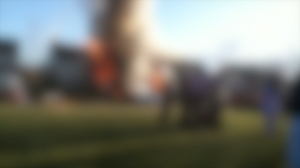 |
Altered, found footage of homes burning. ‘I investigate the uses and usefulness of images. My questions include: How are images experienced? Where does the value in an image exist? Can the point in which meaning adheres to representations be shifted? And what is the role of images in constructing personal and collective perspectives and understandings? Combing the current image torrent, I alter visual content in a search for new possibilities of visuality and perception.’ Zach Nader is a Brooklyn, NY based artist that investigates uses and usefulness of images. Nader has recently exhibited at Jen Bekman Gallery, NURTUREart, Magenta Flash Forward Festival with Humble Arts Foundation, Houston Center for Photography, and Yaffo 23 in Jerusalem, Israel. He recently had a solo video screening at Microscope Gallery in Brooklyn, NY. He also helps run usefulpictur.es, a site highlighting the work of artists that actively seek to complicate current understandings of photographic images, and conducts artist interviews for layflat.org. |
| Daniel Terna in collaboration with Michael Kugler | Before After | 2011 | 16:17 min. | |
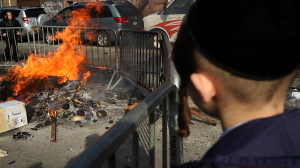 |
Before After explores South Williamsburg Brooklyn through a series of filmed experiments and encounters in the mostly Latino and Jewish communities. The camera is considered as a compass that gives direction to a variety of inquiries. This compass guided interactions with the neighborhood, both in terms of physical space and its inhabitants, and consequently the neighborhood began to be approached and considered as a spacious urban playground. The short sequences in this piece are the result of unexpected encounters with people, images, and local rituals. Objects were used as props to facilitate interventions with spaces and communications with people. The title, Before After, references a photography storefront sign along Lee Avenue in the heart of the Jewish neighborhood, and it reminds us that deciding when something is “over” or “finished” is easier said than “done.” Produced in cooperation with the UnionDocs Collaborative. Michael Kugler is an artist living and working in Weimar Germany. Daniel Terna (Brooklyn, NY) works primarily in photography and video. His work questions when and why we choose to make photographs, and examines the relationship we have had with photography in the past and what it is today. Terna’s video work blends personal narratives with a tourist’s approach to photography, making him both participant and critic. Terna’s photographs and videos have been exhibited in New York at UnionDocs, Outpost Artist Resources, NurtureArt Gallery, the AC Institute, Rabbithole Gallery, and the Austrian Cultural Forum. He has also screened at the Contemporary Arts Center (New Orleans), Carpenter Center for the Visual Arts (Cambridge, MA), Armory Center for the Arts (Pasadena, CA), and Gallery Tayuta (Tokyo). Terna graduated with a BA in photography from Bard College. |
 |
 |



